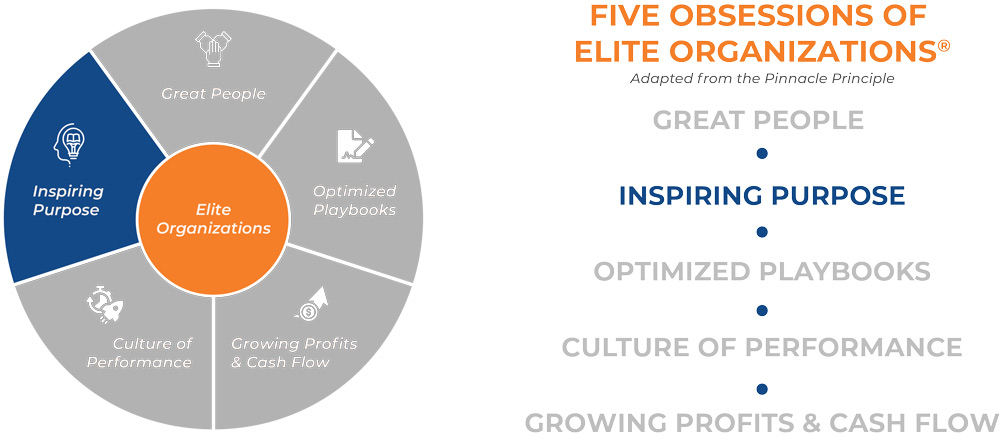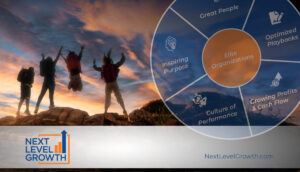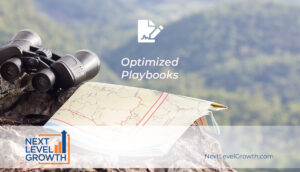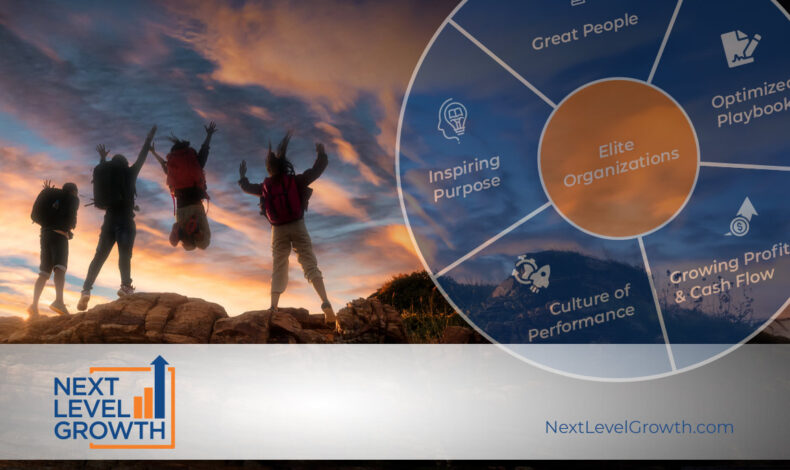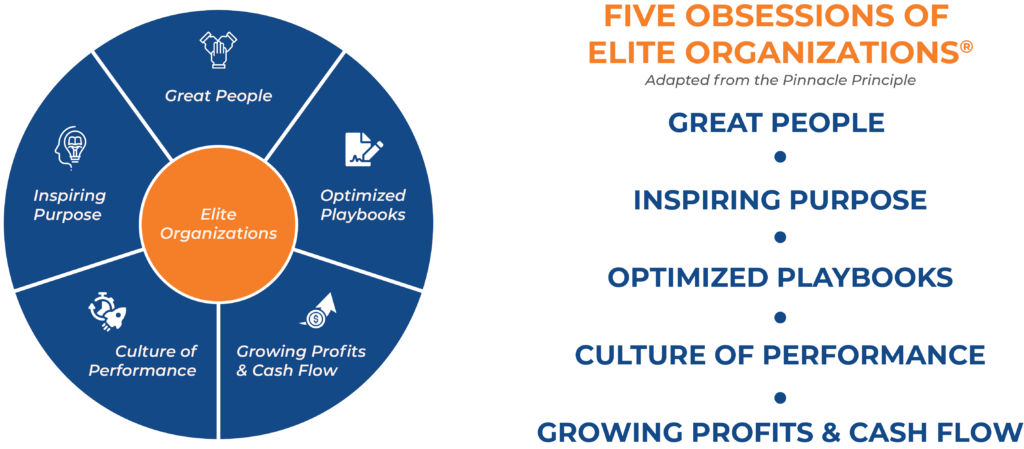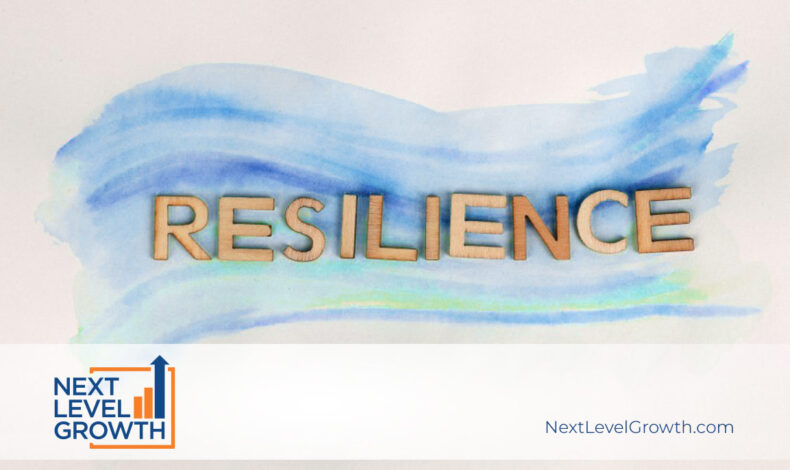Finding and Developing Your A-Players
The problem, especially in today’s labor market, is that most organizations have several “potential” A-Players already inside the company. They just aren’t getting the clarity of expectations and coaching they need to perform at their natural best. While true A-Players are highly aligned with your core values, have the skillsets and desire to perform their roles at a high level all of the time, and have an emotional attachment to your purpose, this article is going to take a deeper dive on the performance piece of the equation.
The EOS® Accountability Chart
In his 2007 book,
Traction, author and founder of EOS Worldwide
®, Gino Wickman, made a significant improvement to the well-known Org. Chart when he introduced the idea of an Accountability Chart. The purpose was to clarify what the roles and responsibilities were for every seat in the company by adding a few short words or phrases as bullet points in the box for each seat.
In the example of a Sales & Marketing Leadership seat from the book
Traction, those bullet points are: LMA, Sales Goal, Selling, Marketing, Sales & Marketing Process. While a good step in the right direction, when I implemented EOS
® in my own business over 10 years ago, I felt this was an oversimplification and needed to be stronger if it was truly going to set clear expectations to help leaders and managers really identify the right people for the right seats, and either coach people up, or coach people out when they were not performing to expectations.
All of the companies I have worked with over the years have heard me say that
I believe the root of most of our frustrations are based on uncommunicated expectations. This applies in all areas of life, and especially in the relationships between a leader and their direct reports.
The Next Level Accountability Chart™
This led to the creation and evolution of what we teach at Next Level Growth as the
Next Level Accountability Chart™. The critical difference, and in fact the key value of, the Next Level Accountability Chart™ is in establishing what we call MMOs™: Mission, Most Critical Outcome
®, and Obsessions™. With MMOs in place for every seat, both the leader and their direct report will have absolute clarity on what is expected of them, so that they can truly understand if they are in the right seat, and if necessary, get the coaching and development they need, and be clear about where they need it.
Let me share an example, using the same Sales & Marketing Leadership position mentioned from
Traction above. First, to the Mission.
Establishing a Clear Mission
We define the “mission” for a seat as a one-sentence description of the consistent, high-level deliverable a seat on the Next Level Accountability Chart™ must achieve to be successful. For example, the Director of Marketing and Sales, or Chief Revenue Officer (insert whatever title you want) might have a mission to:
Consistently grow Target Market lead generation and conversion to meet or exceed revenue goals. It is a simple statement, and should be fairly obvious, but this is high level, and highly measurable, which creates clarity and accountability. We have a budget for the year, and if this leader drives sufficient target market growth in lead generation and successfully converts the leads at the conversion rate necessary to meet our budget, the company will likely meet or exceed its revenue goals, and we can measure, track and discuss performance around this mission on a consistent basis.
Most Critical Outcome®
Second, the
Most Critical Outcome® (MCO™) is defined as the single most important and measurable outcome for a function. At the Leadership Team level, the MCO is almost always a lagging indicator and typically should be tracked on a monthly team scorecard, by person. The 2-4 primary drivers of each MCO are usually measurable leading activities and should be tracked on your team’s weekly scorecard. The Most Critical Outcome
® should also answer the question, “
If you were asked to measure one thing that most accurately proves you are getting a return on investment for the fully burdened human capital cost of a specific person in a given seat, what would you measure?”
In the case of our Director of Sales and Marketing, their MCO may be as simple as “
Revenue Dollars to Goal (budget/forecast).” If the company is consistently meeting or exceeding revenue forecasts, it is very likely that the Director of Marketing and Sales is performing at a high level in leading their team and generating a sufficient return on investment.
Defining Obsessions
Lastly, we define Obsessions as anywhere from 2 to 6 things that a seat-holder must obsess about on a daily basis to be successful (usually around 4-6 at a senior leadership level and as few as 2-3 for a front-line employee). While the EOS Accountability Chart uses just a single word or short phrase for each of the roles or responsibilities, I believe there is still too much ambiguity and room for interpretation and confusion. If you look at the example from
Traction above, it can be difficult to truly hold people accountable to “selling.” What exactly does that mean in terms of how you measure a person’s success?
When you have a clearly established Mission, with the right MCO, the obsessions become a strong way to align expectations around where a team member must focus in order to be successful at the level of an A-Player. For example, the Obsessions I might suggest for a Director of Marketing and Sales could be:
1 –
Lead, manage, retain & hold my team accountable. I personally prefer to start with this one for anyone who has a direct report. When I work with companies who have used EOS and later upgraded to Next Level Growth, many people cannot articulate and explain what LMA really means. With our approach, we can specifically evaluate a team leader on how well they are “
leading” the team. Is there dissention, harmony, etc. There are things we can observe and use to provide feedback to help the leader improve if needed. We can look at how they “
manage” the team on a daily basis and provide coaching and feedback. We can look at “
retention” on the team.
Most people go to work for an organization but quit their boss. If a team lead has trouble retaining their high performers, then they need to be coached in that area. Finally, in the LMA concept from EOS, accountability is a byproduct of effective leadership and management. While I agree in theory, in the real world, I have found that when leaders are not willing to have the tough conversations to hold their teams accountable when needed, the teams underperform. Measuring how well a team lead holds their team accountable is actually not very difficult at all.
2 –
Own the Marketing and Sales Strategies, Plans and Outcomes. If the person in this seat focuses their energy on getting the marketing and sales strategies right, developing and updating the right plans to execute on the strategy, and tracking outcomes to make adjustments where needed, we have them laser focused on a strategic approach to growing our pipeline, conversion, and revenue. If, over time, they cannot get the right strategy and plan in place to achieve the desired outcome, they are likely not the right person for the seat.
3 –
Own the Marketing and Sales Process Playbooks and Execution. With the right strategies and plans in place, to be successful in this role, an A-Player will obsess about the playbooks and making sure that everyone on the sales team is following them. So many times, when I start digging into a company’s “sales playbook,” I find that they really don’t have one, and everyone on the sales team is more or less doing their own thing. With a strong leader in place, the team can develop some best practices and optimize how they run their sales plays to help improve conversion throughout the sales funnel and accelerate growth.
4 –
Consistently meet or exceed goals and metrics. While this one may be implied, I like to include it anyway. If I’m going to give a person in this seat four things to obsess about on a daily basis, I want one of those to be their goals and metrics.
So, if on a daily basis the Director of Marketing and Sales truly obsesses about leading, managing, retaining and holding their team accountable; owning the marketing and sales strategies, plans, outcomes, playbooks and execution, and meeting or exceeding their goals and metrics, they are very likely to be highly successful in the role, or else it will become very obvious, very fast, that they are not right for the seat.
Next Level Accountability Chart™ – Going Deeper
Now that we understand what the Director of Marketing and Sales must own, let’s look at how a direct report, perhaps an Outside Salesperson’s seat, might be established.
You may notice that each Obsession in the Next Level Accountability Chart™ contains a verb. That is because these obsessions are about taking action, and it is important to get the verbs right if you’re going to create clarity. When we suggest the verb “own,” for a Leadership Team member, what we mean by that is if something isn’t working, and they own it, it is their job to fix it. If they get stuck, the rest of the team is there to help, but the vast majority of the time, they should have the competence to fix what they own when it isn’t getting the desired result, or they may be in the wrong seat.
For an outside sales seat, we may establish their Mission as something like, “Consistently grow and convert my pipeline to meet or exceed my new revenue goals.” This mission, when achieved, supports the mission of the person to whom they report. The corresponding MCO would likely then be, “New revenue dollars to individual goal.”
When rolling out their Obsessions, we start by looking at the seat to which they report. Since this person will have no direct reports, the Obsession around Leading and Managing does not apply. They might, however, have an Obsession that stems from the second Obsession of their leader, and that might be to, “Follow and successfully execute my sales plan.”
Notice that the verb changed to “follow.” This is important, because for this person, you don’t want them making up, or modifying their sales plan without working with their boss. You want them to buy in to the plan, and then obsess about following and successfully executing it.
Another obsession might be to, “Follow the Sales Process Playbook.” If the Director “owns” the Sales Process Playbook, you likely want the salespeople to obsess about following the Playbook.
Finally, I like to suggest including the Obsession to, “Meet or exceed my goals and metrics.”
It’s really that simple.
When you have a salesperson in the field, if they will just obsess about executing on their individual sales plan, following the sales playbooks, and meeting or exceeding their goals and metrics, and if their boss has taken ownership of creating great plans and playbooks, they have a much greater chance of being successful in their role. With this level of clarity, consistency, and focus, the employee wins, their boss wins, the customer wins, and the company wins.
Coaching Up or Coaching Out with Clarity
Remember, the root of most frustrations is based on uncommunicated expectations. Use the Next Level Accountability Chart™ approach to improve the clarity of expectations within your organization, coach people who need to be either coached up or coached out, and level up your overall performance, profitability, and growth.



